Rainbow Illusion: Revenue Cycle Analysis - University Business Report
VerifiedAdded on 2022/11/19
|14
|3146
|2
Report
AI Summary
This report provides a comprehensive analysis of the revenue cycle of Rainbow Illusion, a retail chain operating in New South Wales and Victoria. It evaluates the company's internal controls, identifies six key strengths in its sales transaction system, and analyzes the problems mitigated by these strengths. The report further explores potential situational pressures that could increase the risk of fraud within the organization, such as financial pressures and employee relations. It also considers the advantages of a centralized system and assesses the potential benefits of adapting a distributed computer system. The report emphasizes the importance of understanding and managing the revenue cycle to improve efficiency, prevent fraud, and ensure the long-term financial health of the business. The report covers various aspects like strengths, weaknesses, fraud risks, and the need to implement a distributed computer system rather than a centralized system.
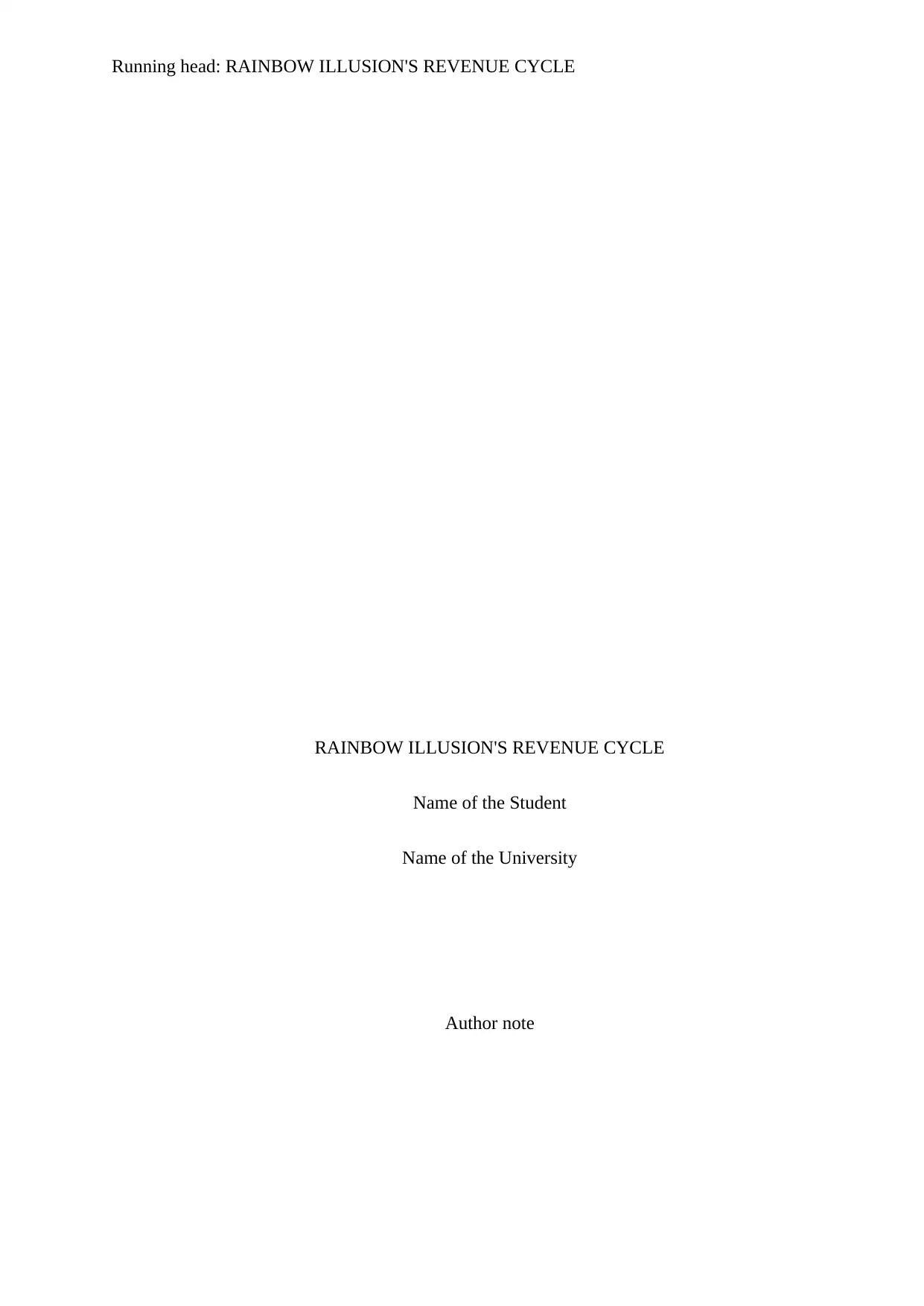
Running head: RAINBOW ILLUSION'S REVENUE CYCLE
RAINBOW ILLUSION'S REVENUE CYCLE
Name of the Student
Name of the University
Author note
RAINBOW ILLUSION'S REVENUE CYCLE
Name of the Student
Name of the University
Author note
Paraphrase This Document
Need a fresh take? Get an instant paraphrase of this document with our AI Paraphraser
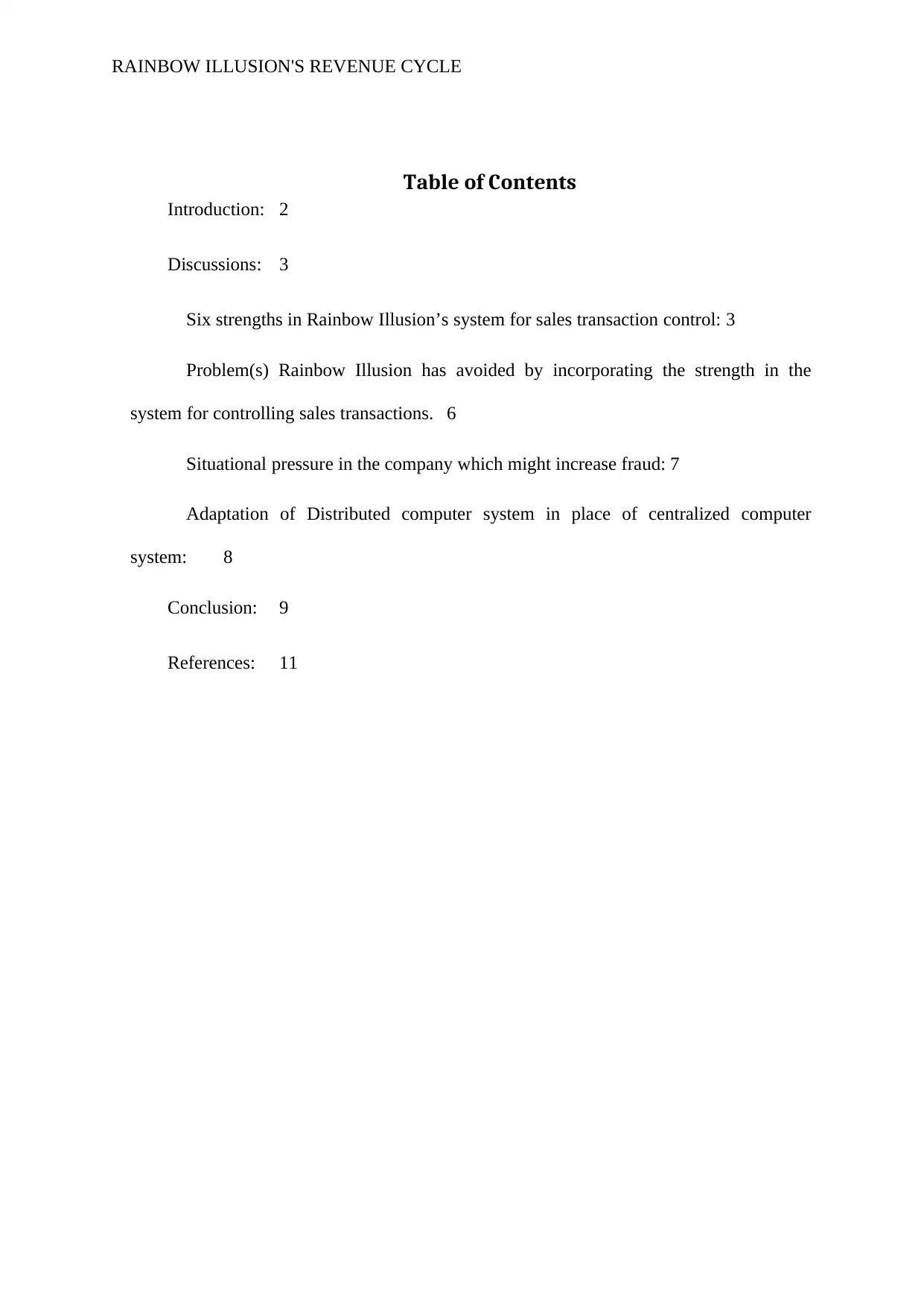
RAINBOW ILLUSION'S REVENUE CYCLE
Table of Contents
Introduction: 2
Discussions: 3
Six strengths in Rainbow Illusion’s system for sales transaction control: 3
Problem(s) Rainbow Illusion has avoided by incorporating the strength in the
system for controlling sales transactions. 6
Situational pressure in the company which might increase fraud: 7
Adaptation of Distributed computer system in place of centralized computer
system: 8
Conclusion: 9
References: 11
Table of Contents
Introduction: 2
Discussions: 3
Six strengths in Rainbow Illusion’s system for sales transaction control: 3
Problem(s) Rainbow Illusion has avoided by incorporating the strength in the
system for controlling sales transactions. 6
Situational pressure in the company which might increase fraud: 7
Adaptation of Distributed computer system in place of centralized computer
system: 8
Conclusion: 9
References: 11
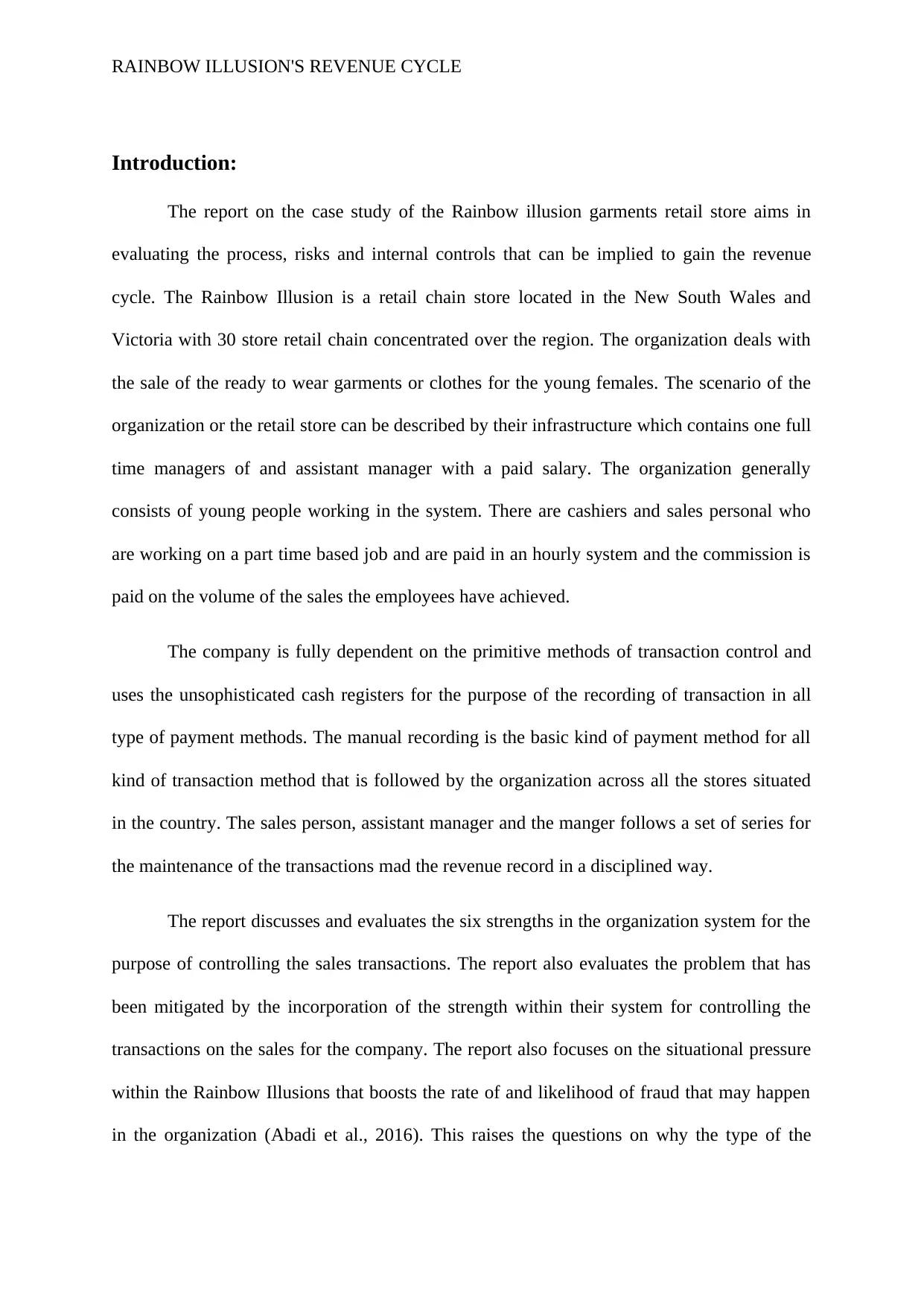
RAINBOW ILLUSION'S REVENUE CYCLE
Introduction:
The report on the case study of the Rainbow illusion garments retail store aims in
evaluating the process, risks and internal controls that can be implied to gain the revenue
cycle. The Rainbow Illusion is a retail chain store located in the New South Wales and
Victoria with 30 store retail chain concentrated over the region. The organization deals with
the sale of the ready to wear garments or clothes for the young females. The scenario of the
organization or the retail store can be described by their infrastructure which contains one full
time managers of and assistant manager with a paid salary. The organization generally
consists of young people working in the system. There are cashiers and sales personal who
are working on a part time based job and are paid in an hourly system and the commission is
paid on the volume of the sales the employees have achieved.
The company is fully dependent on the primitive methods of transaction control and
uses the unsophisticated cash registers for the purpose of the recording of transaction in all
type of payment methods. The manual recording is the basic kind of payment method for all
kind of transaction method that is followed by the organization across all the stores situated
in the country. The sales person, assistant manager and the manger follows a set of series for
the maintenance of the transactions mad the revenue record in a disciplined way.
The report discusses and evaluates the six strengths in the organization system for the
purpose of controlling the sales transactions. The report also evaluates the problem that has
been mitigated by the incorporation of the strength within their system for controlling the
transactions on the sales for the company. The report also focuses on the situational pressure
within the Rainbow Illusions that boosts the rate of and likelihood of fraud that may happen
in the organization (Abadi et al., 2016). This raises the questions on why the type of the
Introduction:
The report on the case study of the Rainbow illusion garments retail store aims in
evaluating the process, risks and internal controls that can be implied to gain the revenue
cycle. The Rainbow Illusion is a retail chain store located in the New South Wales and
Victoria with 30 store retail chain concentrated over the region. The organization deals with
the sale of the ready to wear garments or clothes for the young females. The scenario of the
organization or the retail store can be described by their infrastructure which contains one full
time managers of and assistant manager with a paid salary. The organization generally
consists of young people working in the system. There are cashiers and sales personal who
are working on a part time based job and are paid in an hourly system and the commission is
paid on the volume of the sales the employees have achieved.
The company is fully dependent on the primitive methods of transaction control and
uses the unsophisticated cash registers for the purpose of the recording of transaction in all
type of payment methods. The manual recording is the basic kind of payment method for all
kind of transaction method that is followed by the organization across all the stores situated
in the country. The sales person, assistant manager and the manger follows a set of series for
the maintenance of the transactions mad the revenue record in a disciplined way.
The report discusses and evaluates the six strengths in the organization system for the
purpose of controlling the sales transactions. The report also evaluates the problem that has
been mitigated by the incorporation of the strength within their system for controlling the
transactions on the sales for the company. The report also focuses on the situational pressure
within the Rainbow Illusions that boosts the rate of and likelihood of fraud that may happen
in the organization (Abadi et al., 2016). This raises the questions on why the type of the
⊘ This is a preview!⊘
Do you want full access?
Subscribe today to unlock all pages.

Trusted by 1+ million students worldwide
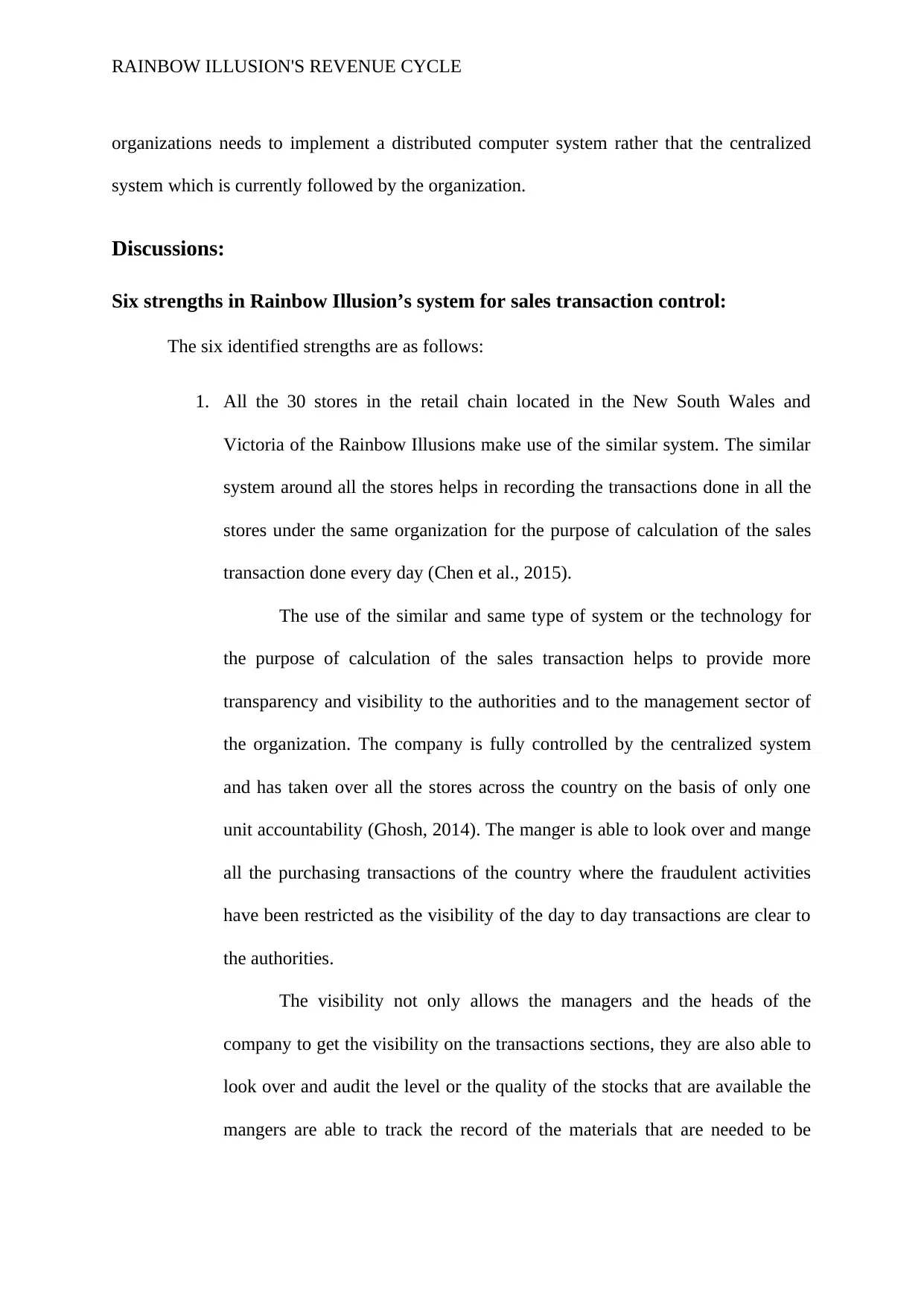
RAINBOW ILLUSION'S REVENUE CYCLE
organizations needs to implement a distributed computer system rather that the centralized
system which is currently followed by the organization.
Discussions:
Six strengths in Rainbow Illusion’s system for sales transaction control:
The six identified strengths are as follows:
1. All the 30 stores in the retail chain located in the New South Wales and
Victoria of the Rainbow Illusions make use of the similar system. The similar
system around all the stores helps in recording the transactions done in all the
stores under the same organization for the purpose of calculation of the sales
transaction done every day (Chen et al., 2015).
The use of the similar and same type of system or the technology for
the purpose of calculation of the sales transaction helps to provide more
transparency and visibility to the authorities and to the management sector of
the organization. The company is fully controlled by the centralized system
and has taken over all the stores across the country on the basis of only one
unit accountability (Ghosh, 2014). The manger is able to look over and mange
all the purchasing transactions of the country where the fraudulent activities
have been restricted as the visibility of the day to day transactions are clear to
the authorities.
The visibility not only allows the managers and the heads of the
company to get the visibility on the transactions sections, they are also able to
look over and audit the level or the quality of the stocks that are available the
mangers are able to track the record of the materials that are needed to be
organizations needs to implement a distributed computer system rather that the centralized
system which is currently followed by the organization.
Discussions:
Six strengths in Rainbow Illusion’s system for sales transaction control:
The six identified strengths are as follows:
1. All the 30 stores in the retail chain located in the New South Wales and
Victoria of the Rainbow Illusions make use of the similar system. The similar
system around all the stores helps in recording the transactions done in all the
stores under the same organization for the purpose of calculation of the sales
transaction done every day (Chen et al., 2015).
The use of the similar and same type of system or the technology for
the purpose of calculation of the sales transaction helps to provide more
transparency and visibility to the authorities and to the management sector of
the organization. The company is fully controlled by the centralized system
and has taken over all the stores across the country on the basis of only one
unit accountability (Ghosh, 2014). The manger is able to look over and mange
all the purchasing transactions of the country where the fraudulent activities
have been restricted as the visibility of the day to day transactions are clear to
the authorities.
The visibility not only allows the managers and the heads of the
company to get the visibility on the transactions sections, they are also able to
look over and audit the level or the quality of the stocks that are available the
mangers are able to track the record of the materials that are needed to be
Paraphrase This Document
Need a fresh take? Get an instant paraphrase of this document with our AI Paraphraser

RAINBOW ILLUSION'S REVENUE CYCLE
purchased for the business so that there are no delay created in the transaction
process.
2. The strengths of the organization’s sales management scheme are, The
salespeople are young and part-time with sales volume incentives. To record
every transaction, the company utilizes unfamiliar money registers with a
four-part sales fact. The salesman transfers the sales invoice to the cabinet
manager who checks the order and starts the sale. Returns are precisely treated
the other way round (Orgerie, Assuncao & Lefevre, 2014). The assistant
manager produces a weekly reconciliation report. A sales and commission
report is submitted to the manager weekly for evaluation by the data
processing department.
3. Another of the company's very significant characteristics would be that the
work of the younger level staff can be tracked by supervisors and executives
directly through the existence of a centralized scheme in the Rainbow Illusions
and that they should also take adequate care and control of the entire scheme.
Another key strength of the business is the fact that the company's average
workers including its sales representative and numerous others are young,
which is an excellent motive for job and effort (Tian & Peterson, 2016).
4. The involvement of the younger generations or the recruitment of the younger
employees in the organization have provided with some unique advantages to
the company. The younger workforce tends to know and direct the sales of the
company according to the new or the current generation (Laudon & Laudon,
2016). The new generation’s fashion sense is known best by the younger
employees, the company is benefited by their ideas about the fashion trends
purchased for the business so that there are no delay created in the transaction
process.
2. The strengths of the organization’s sales management scheme are, The
salespeople are young and part-time with sales volume incentives. To record
every transaction, the company utilizes unfamiliar money registers with a
four-part sales fact. The salesman transfers the sales invoice to the cabinet
manager who checks the order and starts the sale. Returns are precisely treated
the other way round (Orgerie, Assuncao & Lefevre, 2014). The assistant
manager produces a weekly reconciliation report. A sales and commission
report is submitted to the manager weekly for evaluation by the data
processing department.
3. Another of the company's very significant characteristics would be that the
work of the younger level staff can be tracked by supervisors and executives
directly through the existence of a centralized scheme in the Rainbow Illusions
and that they should also take adequate care and control of the entire scheme.
Another key strength of the business is the fact that the company's average
workers including its sales representative and numerous others are young,
which is an excellent motive for job and effort (Tian & Peterson, 2016).
4. The involvement of the younger generations or the recruitment of the younger
employees in the organization have provided with some unique advantages to
the company. The younger workforce tends to know and direct the sales of the
company according to the new or the current generation (Laudon & Laudon,
2016). The new generation’s fashion sense is known best by the younger
employees, the company is benefited by their ideas about the fashion trends
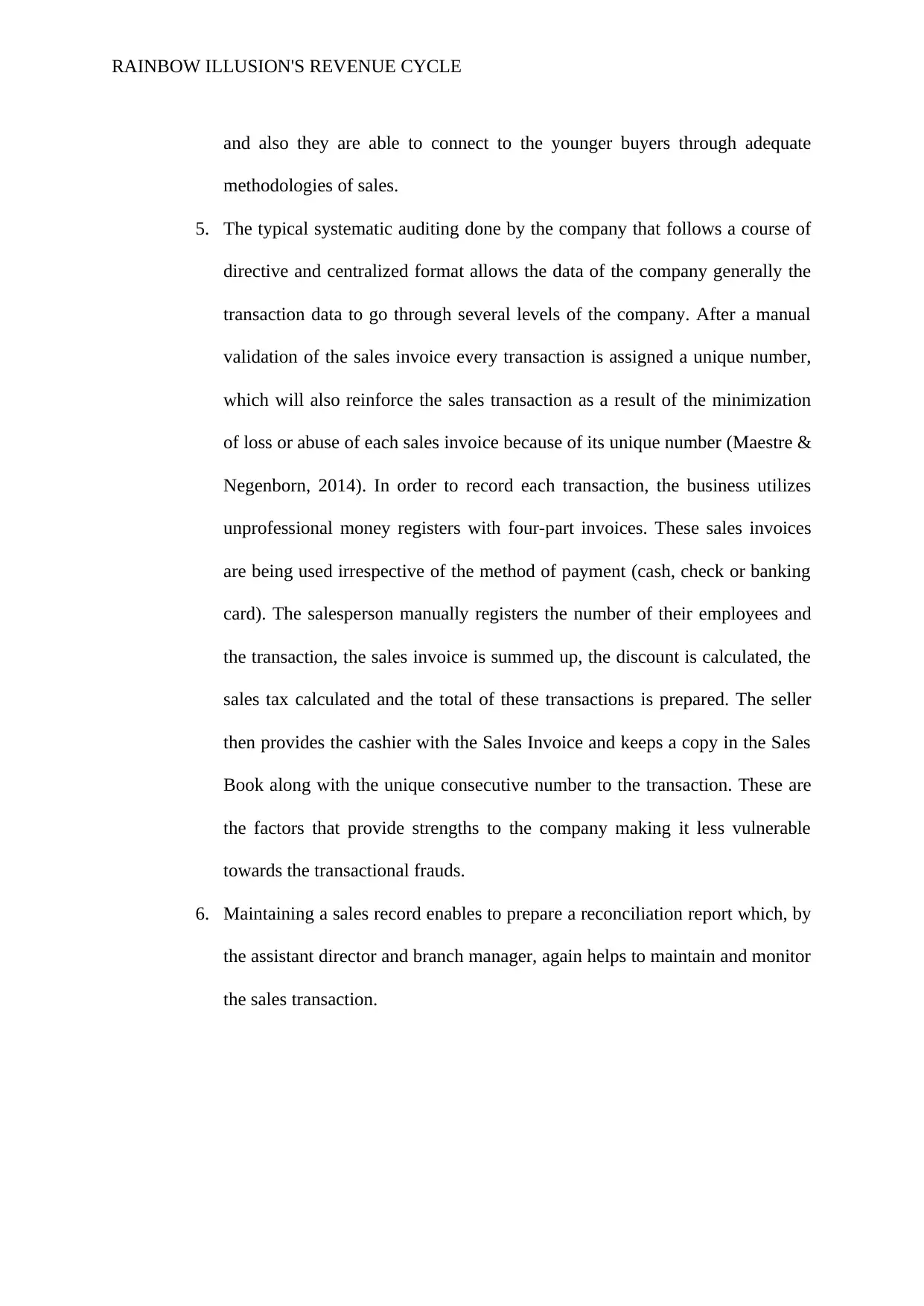
RAINBOW ILLUSION'S REVENUE CYCLE
and also they are able to connect to the younger buyers through adequate
methodologies of sales.
5. The typical systematic auditing done by the company that follows a course of
directive and centralized format allows the data of the company generally the
transaction data to go through several levels of the company. After a manual
validation of the sales invoice every transaction is assigned a unique number,
which will also reinforce the sales transaction as a result of the minimization
of loss or abuse of each sales invoice because of its unique number (Maestre &
Negenborn, 2014). In order to record each transaction, the business utilizes
unprofessional money registers with four-part invoices. These sales invoices
are being used irrespective of the method of payment (cash, check or banking
card). The salesperson manually registers the number of their employees and
the transaction, the sales invoice is summed up, the discount is calculated, the
sales tax calculated and the total of these transactions is prepared. The seller
then provides the cashier with the Sales Invoice and keeps a copy in the Sales
Book along with the unique consecutive number to the transaction. These are
the factors that provide strengths to the company making it less vulnerable
towards the transactional frauds.
6. Maintaining a sales record enables to prepare a reconciliation report which, by
the assistant director and branch manager, again helps to maintain and monitor
the sales transaction.
and also they are able to connect to the younger buyers through adequate
methodologies of sales.
5. The typical systematic auditing done by the company that follows a course of
directive and centralized format allows the data of the company generally the
transaction data to go through several levels of the company. After a manual
validation of the sales invoice every transaction is assigned a unique number,
which will also reinforce the sales transaction as a result of the minimization
of loss or abuse of each sales invoice because of its unique number (Maestre &
Negenborn, 2014). In order to record each transaction, the business utilizes
unprofessional money registers with four-part invoices. These sales invoices
are being used irrespective of the method of payment (cash, check or banking
card). The salesperson manually registers the number of their employees and
the transaction, the sales invoice is summed up, the discount is calculated, the
sales tax calculated and the total of these transactions is prepared. The seller
then provides the cashier with the Sales Invoice and keeps a copy in the Sales
Book along with the unique consecutive number to the transaction. These are
the factors that provide strengths to the company making it less vulnerable
towards the transactional frauds.
6. Maintaining a sales record enables to prepare a reconciliation report which, by
the assistant director and branch manager, again helps to maintain and monitor
the sales transaction.
⊘ This is a preview!⊘
Do you want full access?
Subscribe today to unlock all pages.

Trusted by 1+ million students worldwide

RAINBOW ILLUSION'S REVENUE CYCLE
Problem(s) Rainbow Illusion has avoided by incorporating the strength in the
system for controlling sales transactions.
The Rainbow Illusion business has some issues and shortcomings that it has prevented
in strengthening their marketing activities. The issues generated by integrating its strengths
are as follows:
1. The enterprise had the issue of de-motivating staff and this scheme was solved by the
centralized scheme. The reality, however, which young staff lack much business
experience caused several issues in the business that the business avoided and hence
the work of young people benefitted the organization, Rainbow Illusions. The
employment of young workers in sales and finance certainly contributed to improving
the business financially.
2. Strengthening Rainbow Illusion in terms of income generation and sales transaction
management and improvement contributes to the general improvement in the
economic and transaction sectors. The existence of the centralized scheme in the
Rainbow Illusions infrastructure has made it difficult for people to doubt their work
and duties (Åström & Wittenmark, 2013)).
3. Complexity and time loss led in the verification of the sales invoice at many of the
organization’s hierarchical levels. The Rainbow Illusions business assigned the
directors and executives to this method which solved the issue and monitored and
retained the sales transaction (Sommer et al., 2013). The business representatives also
kept the sales invoice integrity by adding a single amount with each receipt of the
sales invoice and therefore the company's issues were addressed by integrating the
weaknesses.
Problem(s) Rainbow Illusion has avoided by incorporating the strength in the
system for controlling sales transactions.
The Rainbow Illusion business has some issues and shortcomings that it has prevented
in strengthening their marketing activities. The issues generated by integrating its strengths
are as follows:
1. The enterprise had the issue of de-motivating staff and this scheme was solved by the
centralized scheme. The reality, however, which young staff lack much business
experience caused several issues in the business that the business avoided and hence
the work of young people benefitted the organization, Rainbow Illusions. The
employment of young workers in sales and finance certainly contributed to improving
the business financially.
2. Strengthening Rainbow Illusion in terms of income generation and sales transaction
management and improvement contributes to the general improvement in the
economic and transaction sectors. The existence of the centralized scheme in the
Rainbow Illusions infrastructure has made it difficult for people to doubt their work
and duties (Åström & Wittenmark, 2013)).
3. Complexity and time loss led in the verification of the sales invoice at many of the
organization’s hierarchical levels. The Rainbow Illusions business assigned the
directors and executives to this method which solved the issue and monitored and
retained the sales transaction (Sommer et al., 2013). The business representatives also
kept the sales invoice integrity by adding a single amount with each receipt of the
sales invoice and therefore the company's issues were addressed by integrating the
weaknesses.
Paraphrase This Document
Need a fresh take? Get an instant paraphrase of this document with our AI Paraphraser
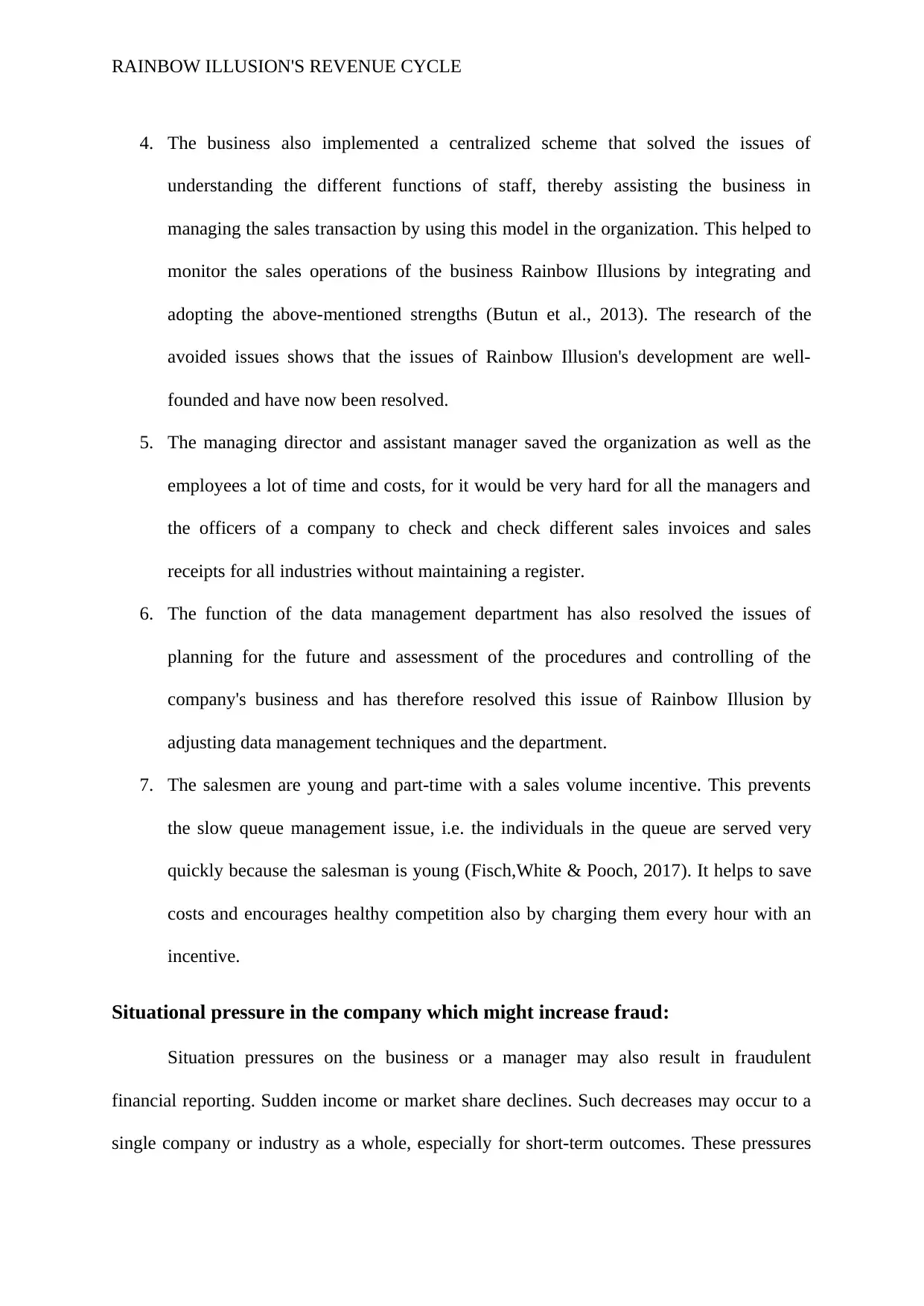
RAINBOW ILLUSION'S REVENUE CYCLE
4. The business also implemented a centralized scheme that solved the issues of
understanding the different functions of staff, thereby assisting the business in
managing the sales transaction by using this model in the organization. This helped to
monitor the sales operations of the business Rainbow Illusions by integrating and
adopting the above-mentioned strengths (Butun et al., 2013). The research of the
avoided issues shows that the issues of Rainbow Illusion's development are well-
founded and have now been resolved.
5. The managing director and assistant manager saved the organization as well as the
employees a lot of time and costs, for it would be very hard for all the managers and
the officers of a company to check and check different sales invoices and sales
receipts for all industries without maintaining a register.
6. The function of the data management department has also resolved the issues of
planning for the future and assessment of the procedures and controlling of the
company's business and has therefore resolved this issue of Rainbow Illusion by
adjusting data management techniques and the department.
7. The salesmen are young and part-time with a sales volume incentive. This prevents
the slow queue management issue, i.e. the individuals in the queue are served very
quickly because the salesman is young (Fisch,White & Pooch, 2017). It helps to save
costs and encourages healthy competition also by charging them every hour with an
incentive.
Situational pressure in the company which might increase fraud:
Situation pressures on the business or a manager may also result in fraudulent
financial reporting. Sudden income or market share declines. Such decreases may occur to a
single company or industry as a whole, especially for short-term outcomes. These pressures
4. The business also implemented a centralized scheme that solved the issues of
understanding the different functions of staff, thereby assisting the business in
managing the sales transaction by using this model in the organization. This helped to
monitor the sales operations of the business Rainbow Illusions by integrating and
adopting the above-mentioned strengths (Butun et al., 2013). The research of the
avoided issues shows that the issues of Rainbow Illusion's development are well-
founded and have now been resolved.
5. The managing director and assistant manager saved the organization as well as the
employees a lot of time and costs, for it would be very hard for all the managers and
the officers of a company to check and check different sales invoices and sales
receipts for all industries without maintaining a register.
6. The function of the data management department has also resolved the issues of
planning for the future and assessment of the procedures and controlling of the
company's business and has therefore resolved this issue of Rainbow Illusion by
adjusting data management techniques and the department.
7. The salesmen are young and part-time with a sales volume incentive. This prevents
the slow queue management issue, i.e. the individuals in the queue are served very
quickly because the salesman is young (Fisch,White & Pooch, 2017). It helps to save
costs and encourages healthy competition also by charging them every hour with an
incentive.
Situational pressure in the company which might increase fraud:
Situation pressures on the business or a manager may also result in fraudulent
financial reporting. Sudden income or market share declines. Such decreases may occur to a
single company or industry as a whole, especially for short-term outcomes. These pressures

RAINBOW ILLUSION'S REVENUE CYCLE
could occur whenever a business has determined profit objectives and the budgets arbitrarily
without taking into consideration the conditions in effect. Financial pressure resulting from
bonus plans depending on short-term economic performance.
The pressure on the situation also includes the pressure caused by the employees of
the entire organization and the loss of their performance. The clashes between employees and
managers can be one such situation because the checking of sales invoices in everyday life
could cause several problems within the companies. The sales invoice slips are tracked and
supervised daily by the management team and the executives, and this may cause a issue with
situations. This issue is mainly owing to the reality that the sales invoices are checked at the
management stage, so any invoice confusion or miscalculation could pose an issue.
The relationship between staff and executives and could therefore generate an
organisational situational stress that will ultimately reduce the company's revenue and
efficiency and, most importantly, the likelihood of fraud could be increased by such errors.
The relationship between staff and executives and could therefore generate an organisational
situational stress that will ultimately reduce the company's revenue and efficiency and, most
importantly, the likelihood of fraud could be increased by such errors (Bhatkar, 2017). The
structure of employees depends a lot on part-time employees working across Rainbow
Illusion’s branches of a young generation and if employees leave the organization suddenly
as they aren't periodic, fixed staff, a great situational stress could arise.
Adaptation of Distributed computer system in place of centralized computer
system:
The centralized system relates to the easiest model, a centralized server that is
attached to many customers and nodes, to be understood and implemented. Most of the
organisation adopts this because client responses are obtained and processed straight from the
could occur whenever a business has determined profit objectives and the budgets arbitrarily
without taking into consideration the conditions in effect. Financial pressure resulting from
bonus plans depending on short-term economic performance.
The pressure on the situation also includes the pressure caused by the employees of
the entire organization and the loss of their performance. The clashes between employees and
managers can be one such situation because the checking of sales invoices in everyday life
could cause several problems within the companies. The sales invoice slips are tracked and
supervised daily by the management team and the executives, and this may cause a issue with
situations. This issue is mainly owing to the reality that the sales invoices are checked at the
management stage, so any invoice confusion or miscalculation could pose an issue.
The relationship between staff and executives and could therefore generate an
organisational situational stress that will ultimately reduce the company's revenue and
efficiency and, most importantly, the likelihood of fraud could be increased by such errors.
The relationship between staff and executives and could therefore generate an organisational
situational stress that will ultimately reduce the company's revenue and efficiency and, most
importantly, the likelihood of fraud could be increased by such errors (Bhatkar, 2017). The
structure of employees depends a lot on part-time employees working across Rainbow
Illusion’s branches of a young generation and if employees leave the organization suddenly
as they aren't periodic, fixed staff, a great situational stress could arise.
Adaptation of Distributed computer system in place of centralized computer
system:
The centralized system relates to the easiest model, a centralized server that is
attached to many customers and nodes, to be understood and implemented. Most of the
organisation adopts this because client responses are obtained and processed straight from the
⊘ This is a preview!⊘
Do you want full access?
Subscribe today to unlock all pages.

Trusted by 1+ million students worldwide

RAINBOW ILLUSION'S REVENUE CYCLE
organisations. The centralized system has an overall system composed of a central server and
a number of client nodes, which connect the customers to the primary server and the system
consists of a single system that automatically adjusts and works the entire procedure of the
client server. The inability of the primary server or host can, lead to a system failure. In order
to link the client to both the server, the central system is also linked via different
communication channels. The system is physically safe as the whole system is in a same
place and operates smoothly.
In distributed computer system the purchase in large amounts decreases the
company's costs. Good relationships with the provider can lead in the future to better
discounts and negotiations. The price of transport is also decreased, as shipments are
consolidated. By centralizing the acquisition, investment in inventory can be minimized. The
management of inventory is decreased dramatically (Knechel & Salterio, 2016). Centralized
purchases can prevent duplication of the job. The buying policies can be evenly retained by
central purchases. It is possible to keep centralized records. The quality of the products can
also be retained as a single department is engaged.
The principal benefits of the distributed rather than centralized system are the fact
that, because of the geographical expansion of the scheme, the distributed system has a very
low latency compared with the centralized system, which eventually decreases the time of
reaction of the distributed system to client order and demands (Hopkin, 2018).
Conclusion:
The Rainbow Illusion firm based in New South Wales and Victoria is based on a
manual transaction scheme and has therefore addressed several elements of sales results and
activities. The study highlights the different methods used by Rainbow Illusion to handle and
control the sales invoice, the sales tax calculation and the discount calculation.
organisations. The centralized system has an overall system composed of a central server and
a number of client nodes, which connect the customers to the primary server and the system
consists of a single system that automatically adjusts and works the entire procedure of the
client server. The inability of the primary server or host can, lead to a system failure. In order
to link the client to both the server, the central system is also linked via different
communication channels. The system is physically safe as the whole system is in a same
place and operates smoothly.
In distributed computer system the purchase in large amounts decreases the
company's costs. Good relationships with the provider can lead in the future to better
discounts and negotiations. The price of transport is also decreased, as shipments are
consolidated. By centralizing the acquisition, investment in inventory can be minimized. The
management of inventory is decreased dramatically (Knechel & Salterio, 2016). Centralized
purchases can prevent duplication of the job. The buying policies can be evenly retained by
central purchases. It is possible to keep centralized records. The quality of the products can
also be retained as a single department is engaged.
The principal benefits of the distributed rather than centralized system are the fact
that, because of the geographical expansion of the scheme, the distributed system has a very
low latency compared with the centralized system, which eventually decreases the time of
reaction of the distributed system to client order and demands (Hopkin, 2018).
Conclusion:
The Rainbow Illusion firm based in New South Wales and Victoria is based on a
manual transaction scheme and has therefore addressed several elements of sales results and
activities. The study highlights the different methods used by Rainbow Illusion to handle and
control the sales invoice, the sales tax calculation and the discount calculation.
Paraphrase This Document
Need a fresh take? Get an instant paraphrase of this document with our AI Paraphraser
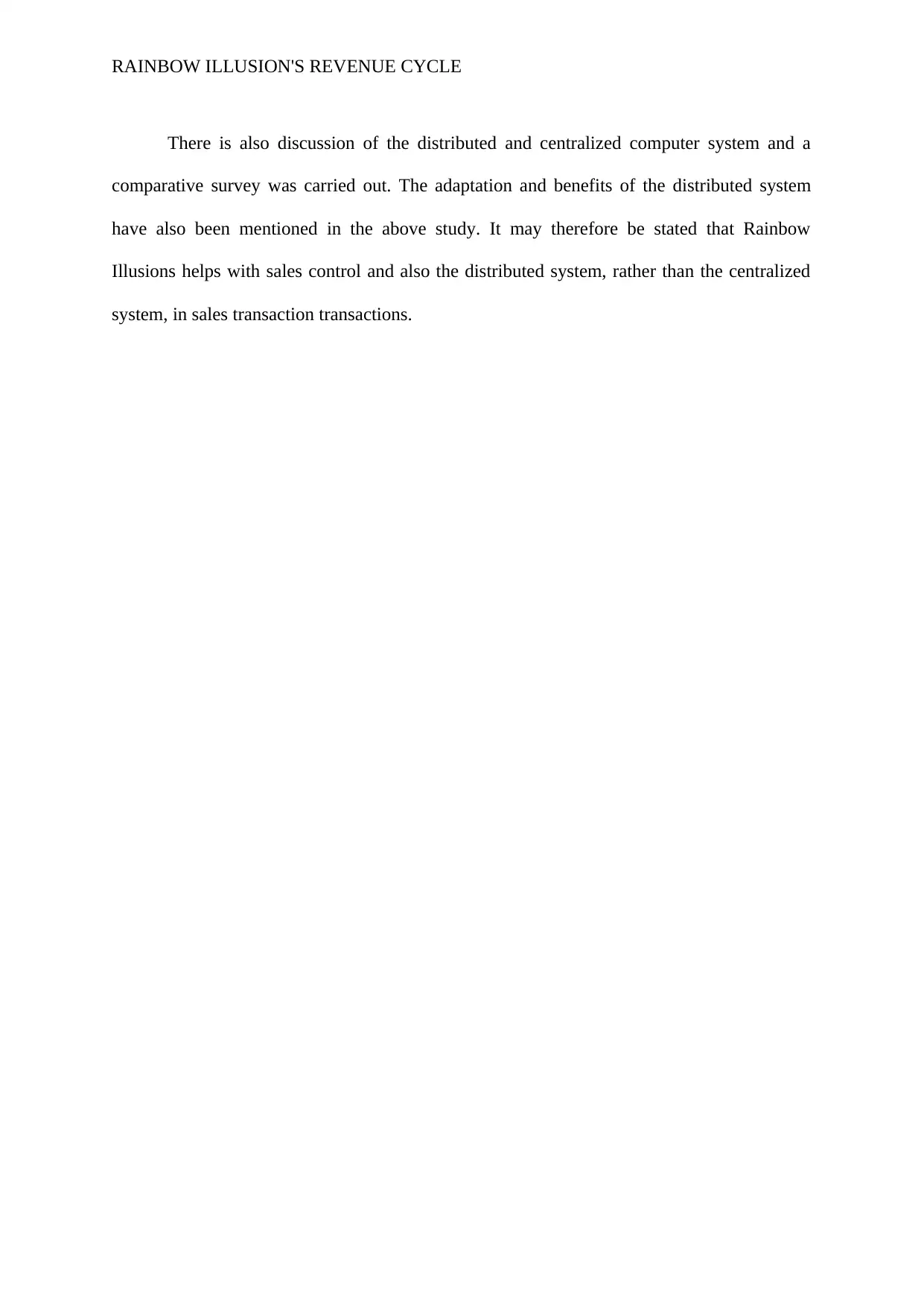
RAINBOW ILLUSION'S REVENUE CYCLE
There is also discussion of the distributed and centralized computer system and a
comparative survey was carried out. The adaptation and benefits of the distributed system
have also been mentioned in the above study. It may therefore be stated that Rainbow
Illusions helps with sales control and also the distributed system, rather than the centralized
system, in sales transaction transactions.
There is also discussion of the distributed and centralized computer system and a
comparative survey was carried out. The adaptation and benefits of the distributed system
have also been mentioned in the above study. It may therefore be stated that Rainbow
Illusions helps with sales control and also the distributed system, rather than the centralized
system, in sales transaction transactions.
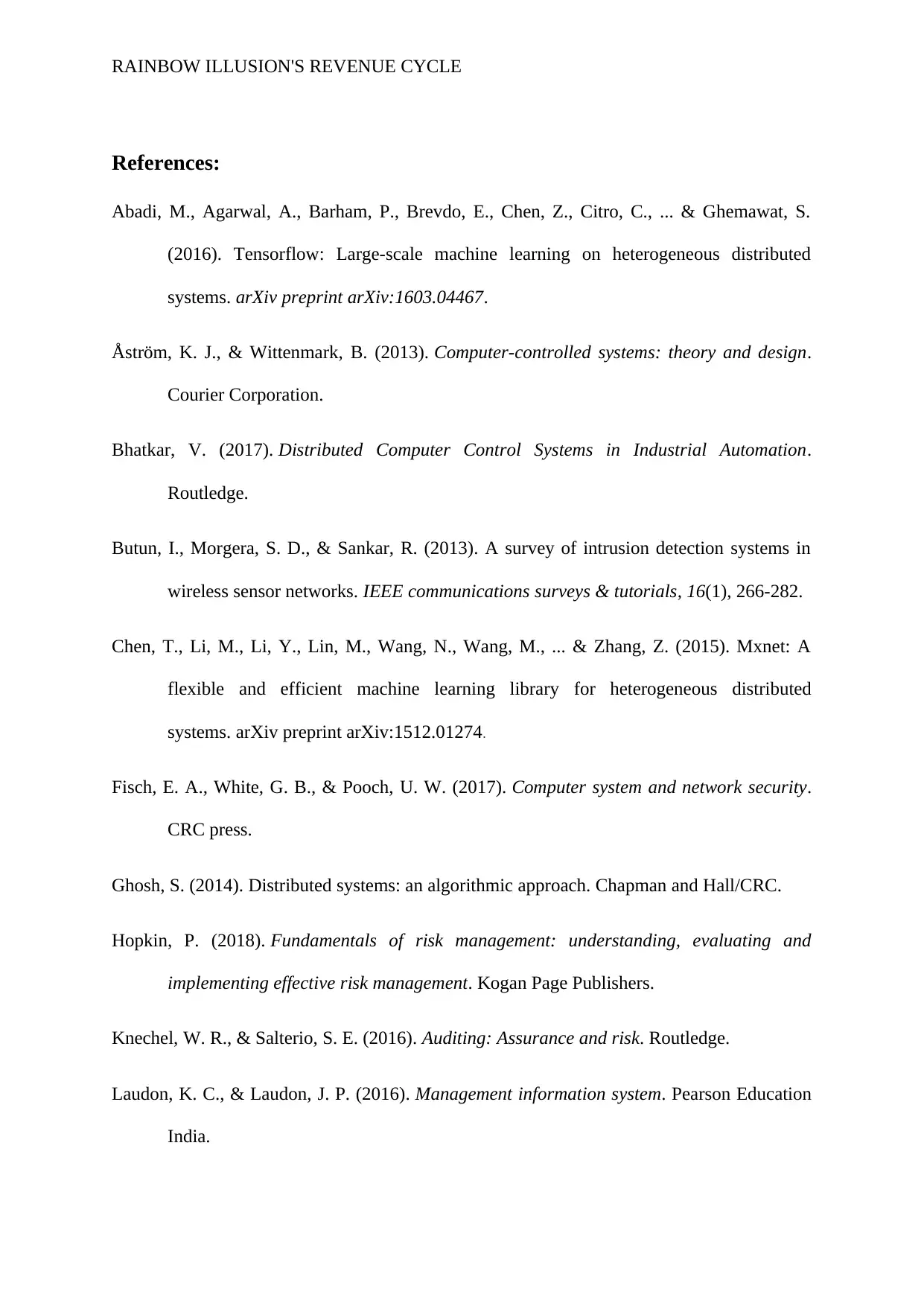
RAINBOW ILLUSION'S REVENUE CYCLE
References:
Abadi, M., Agarwal, A., Barham, P., Brevdo, E., Chen, Z., Citro, C., ... & Ghemawat, S.
(2016). Tensorflow: Large-scale machine learning on heterogeneous distributed
systems. arXiv preprint arXiv:1603.04467.
Åström, K. J., & Wittenmark, B. (2013). Computer-controlled systems: theory and design.
Courier Corporation.
Bhatkar, V. (2017). Distributed Computer Control Systems in Industrial Automation.
Routledge.
Butun, I., Morgera, S. D., & Sankar, R. (2013). A survey of intrusion detection systems in
wireless sensor networks. IEEE communications surveys & tutorials, 16(1), 266-282.
Chen, T., Li, M., Li, Y., Lin, M., Wang, N., Wang, M., ... & Zhang, Z. (2015). Mxnet: A
flexible and efficient machine learning library for heterogeneous distributed
systems. arXiv preprint arXiv:1512.01274.
Fisch, E. A., White, G. B., & Pooch, U. W. (2017). Computer system and network security.
CRC press.
Ghosh, S. (2014). Distributed systems: an algorithmic approach. Chapman and Hall/CRC.
Hopkin, P. (2018). Fundamentals of risk management: understanding, evaluating and
implementing effective risk management. Kogan Page Publishers.
Knechel, W. R., & Salterio, S. E. (2016). Auditing: Assurance and risk. Routledge.
Laudon, K. C., & Laudon, J. P. (2016). Management information system. Pearson Education
India.
References:
Abadi, M., Agarwal, A., Barham, P., Brevdo, E., Chen, Z., Citro, C., ... & Ghemawat, S.
(2016). Tensorflow: Large-scale machine learning on heterogeneous distributed
systems. arXiv preprint arXiv:1603.04467.
Åström, K. J., & Wittenmark, B. (2013). Computer-controlled systems: theory and design.
Courier Corporation.
Bhatkar, V. (2017). Distributed Computer Control Systems in Industrial Automation.
Routledge.
Butun, I., Morgera, S. D., & Sankar, R. (2013). A survey of intrusion detection systems in
wireless sensor networks. IEEE communications surveys & tutorials, 16(1), 266-282.
Chen, T., Li, M., Li, Y., Lin, M., Wang, N., Wang, M., ... & Zhang, Z. (2015). Mxnet: A
flexible and efficient machine learning library for heterogeneous distributed
systems. arXiv preprint arXiv:1512.01274.
Fisch, E. A., White, G. B., & Pooch, U. W. (2017). Computer system and network security.
CRC press.
Ghosh, S. (2014). Distributed systems: an algorithmic approach. Chapman and Hall/CRC.
Hopkin, P. (2018). Fundamentals of risk management: understanding, evaluating and
implementing effective risk management. Kogan Page Publishers.
Knechel, W. R., & Salterio, S. E. (2016). Auditing: Assurance and risk. Routledge.
Laudon, K. C., & Laudon, J. P. (2016). Management information system. Pearson Education
India.
⊘ This is a preview!⊘
Do you want full access?
Subscribe today to unlock all pages.

Trusted by 1+ million students worldwide
1 out of 14
Related Documents
Your All-in-One AI-Powered Toolkit for Academic Success.
+13062052269
info@desklib.com
Available 24*7 on WhatsApp / Email
![[object Object]](/_next/static/media/star-bottom.7253800d.svg)
Unlock your academic potential
Copyright © 2020–2025 A2Z Services. All Rights Reserved. Developed and managed by ZUCOL.





